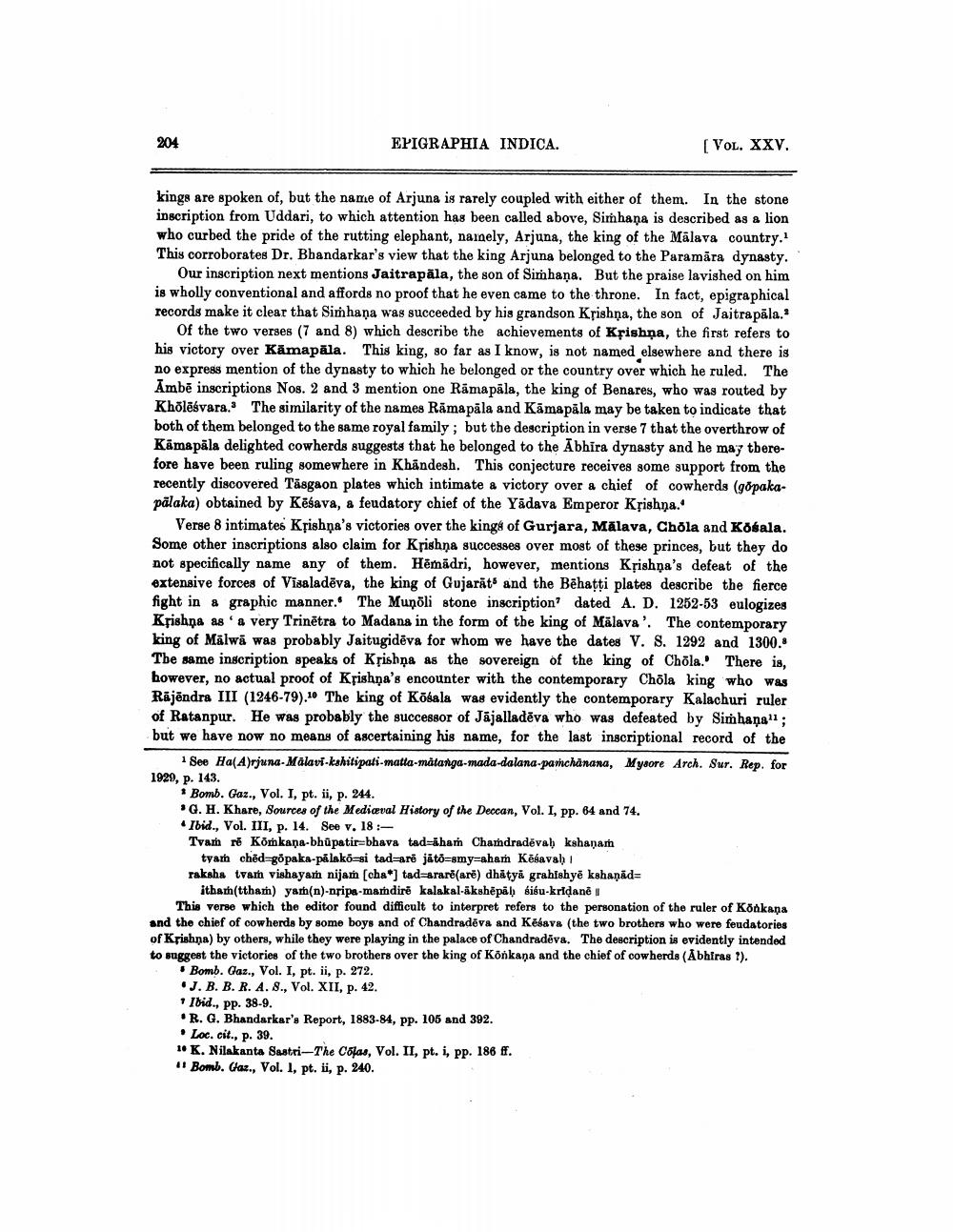________________
204
EPIGRAPHIA INDICA.
[VOL. XXV.
kings are spoken of, but the name of Arjuna is rarely coupled with either of them. In the stone inscription from Uddari, to which attention has been called above, Simhana is described as a lion who curbed the pride of the rutting elephant, namely, Arjuna, the king of the Mälava country. This corroborates Dr. Bhandarkar's view that the king Arjuna belonged to the Paramāra dynasty.
Our inscription next mentions Jaitrapāla, the son of Simhana. But the praise lavished on him is wholly conventional and affords no proof that he even came to the throne. In fact, epigraphical records make it clear that Simhana was succeeded by his grandson Ksishna, the son of Jajtrapāla."
Of the two verses (7 and 8) which describe the achievements of Krishna, the first refers to his victory over Kämapala. This king, so far as I know, is not named elsewhere and there is no express mention of the dynasty to which he belonged or the country over which he ruled. The Ambē inscriptions Nos. 2 and 3 mention one Ramapāla, the king of Benares, who was routed by Khölēgvara.' The similarity of the names Rāma pala and Kämapåla may be taken to indicate that both of them belonged to the same royal family; but the description in verse 7 that the overthrow of Kämapäla delighted cowherds suggests that he belonged to the Abhira dynasty and he may therefore have been ruling somewhere in Khandesh. This conjecture receives some support from the recently discovered Tisgaon plates which intimate a victory over a chief of cowherds (gpakapālaka) obtained by Kēšava, a feudatory chief of the Yādava Emperor Krishna.
Verse 8 intimates Krishna's victories over the king of Gurjara, Mälava, Chola and Kobala. Some other inscriptions also claim for Krishna successes over most of these princes, but they do not specifically name any of them. Hēmādri, however, mentions Krishna's defeat of the extensive forces of Visaladēva, the king of Gujarāts and the Bēhatti plates describe the fierce fight in a graphic manner. The Muņõli stone inscription dated A. D. 1252-53 eulogizes Krishna as a very Trinētra to Madana in the form of the king of Mälava'. The contemporary king of Malwa was probably Jaitugidēva for whom we have the dates V. S. 1292 and 1300.
The same inscription speaks of Krishna as the sovereign of the king of Chöla. There is, however, no actual proof of Krishna's encounter with the contemporary Chola king who was Rajëndra III (1246-79)... The king of Kõsala was evidently the contemporary Kalachuri ruler of Ratanpur. He was probably the successor of Jājalladēva who was defeated by Simhana'; but we have now no means of ascertaining his name, for the last inscriptional record of the
See HalA)rjuna. Malavi-kshitipati-matta-matanga-mada-dalana-panchanana, Mysore Arch. Sur. Rep. for 1929, p. 143.
* Bomb. Gaz., Vol. I, pt. ii, p. 244.
G. H. Khare, Sources of the Mediæral History of the Deccan, Vol. I, pp. 64 and 74. .Ibid., Vol. III, p. 14. See v. 18 - Tvam ro Komkana-bhupatir-bhava tadahan Chandradevah kshanam
tyam ched-gopaka-palakõsi tadarė jäto=smy=aham Kēšavah 1 raksha tvam vishayam nijam (cha*) tad=srare(arē) dhitya grahishye kshanad=
ithar(ttharn) yar(n)-pripa-mamdirē kalakal-akshēpab sisu-kridane This verse which the editor found difficult to interpret refers to the personation of the ruler of Könkana and the chief of cowherds by some boys and of Chandradēva and Késava (the two brothers who were feudatories of Krishna) by others, while they were playing in the palace of Chandradēva. The description is evidently intended to suggest the victories of the two brothers over the king of Könkana and the chief of cowherds (Abhiras ?).
• Bomb. Gaz., Vol. I, pt. ii, p. 272. .J. B. B. R. A. 8., Vol. XII, p. 42. * Ibid., pp. 38-9. .R. G. Bhandarkar's Report, 1883-84, pp. 105 and 392. • Loc. cit., p. 39. 1. K. Nilakanta Sastri-The Clas, Vol. II, pt. i, pp. 186 ff. 11 Bomb. Gaa., Vol. I, pt. ii, p. 240.




